Stansted Airport Transit System
The Stansted Airport Track Transit System (TTS) is a fully automated people mover system which operates within London Stansted Airport in the United Kingdom.[1]
| Stansted Airport Transit System | |||||||||||||||||||||||||||||||||||||||||||||||
|---|---|---|---|---|---|---|---|---|---|---|---|---|---|---|---|---|---|---|---|---|---|---|---|---|---|---|---|---|---|---|---|---|---|---|---|---|---|---|---|---|---|---|---|---|---|---|---|
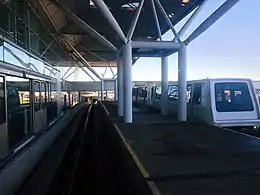 An Adtranz C-100 vehicle approaches the Terminal station | |||||||||||||||||||||||||||||||||||||||||||||||
| Overview | |||||||||||||||||||||||||||||||||||||||||||||||
| Locale | London Stansted Airport, Essex, England, UK | ||||||||||||||||||||||||||||||||||||||||||||||
| Transit type | Automated guideway transit/People mover | ||||||||||||||||||||||||||||||||||||||||||||||
| Number of lines | 1 | ||||||||||||||||||||||||||||||||||||||||||||||
| Number of stations | 3 | ||||||||||||||||||||||||||||||||||||||||||||||
| Daily ridership | 36,000 | ||||||||||||||||||||||||||||||||||||||||||||||
| Annual ridership | 13 million | ||||||||||||||||||||||||||||||||||||||||||||||
| Website | Stansted Airport Terminal Guide | ||||||||||||||||||||||||||||||||||||||||||||||
| Operation | |||||||||||||||||||||||||||||||||||||||||||||||
| Began operation | 1991 | ||||||||||||||||||||||||||||||||||||||||||||||
| Operator(s) | Stansted Airport Limited | ||||||||||||||||||||||||||||||||||||||||||||||
| Character | Elevated (Main Terminal) Underground (Gates 1-39) | ||||||||||||||||||||||||||||||||||||||||||||||
| Rolling stock | 5 × Adtranz C-100 4 × Adtranz CX-100 | ||||||||||||||||||||||||||||||||||||||||||||||
| Number of vehicles | 8 in normal operation; 9 in total | ||||||||||||||||||||||||||||||||||||||||||||||
| Technical | |||||||||||||||||||||||||||||||||||||||||||||||
| System length | 2 miles (3.2 km) | ||||||||||||||||||||||||||||||||||||||||||||||
| Electrification | Third rail | ||||||||||||||||||||||||||||||||||||||||||||||
| |||||||||||||||||||||||||||||||||||||||||||||||
The transit system conveys air passengers between the main airport terminal and the departure/arrival gates, which are located some distance from the main terminal in satellite buildings. The system operates exclusively "airside", meaning that it can only be accessed by passengers who have first passed through airport security. The transit is provided free of charge, with easy access for disabled passengers and being electric far less polluting than the diesel buses that serve the car parks and remote aircraft stands.[2][3]
In April 2023, Manchester Airport Group announced the Stansted TTS would be closing in mid-2025 as part of the Airport Route 43 development.[4] The plan is to replace the TTS system with passenger Sky Link bridges, so both outbound and inbound would walk to their gates. During the development passengers will be transported on buses which will increase the journey time to the boarding gates.
History
The Stansted Airport Transit System was opened in 1991. It was constructed as a result of the decision by the British Airports Authority (BAA) to redevelop the airport with an arrangement of satellite buildings detached from the main terminal. The BAA considered several options for conveying passengers safely and rapidly to the airport gates, including moving walkways, tunnels, bridges and bus links, before opting for an automated tracked transit system. After opening in 1991 the system was extended in 1998 with an additional two underground stations, to serve a second and a third satellite building.[1]
Route
Guideway
The Stansted Airport TTS vehicles run along a double-track guideway totalling 3.2 kilometres (2.0 mi) in length[1] which connects the main terminal building with three satellite buildings. The route begins on an elevated section alongside the departure lounge, before entering a tunnel which passes beneath the airport apron.[5] There is a maintenance depot at one end.
Stations
The Transit System has three stations: Terminal (arrivals and departures), Gates 1–19 (Satellite 1 arrivals and departures) and Gates 20–39 (Satellite 2 arrivals and departures). Satellite 3 (Gates 40–59) is not served by the Transit System; instead a pedestrian footway links the gates with the main terminal.[3]
Each station has segregated boarding and alighting platforms, allowing a more efficient passenger flow. All boarding points are equipped with platform screen doors.
Vehicles
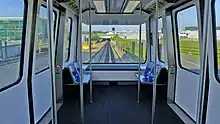
5 Adtranz C-100 cars built by Westinghouse for the system, with car bodies built in Scotland by Walter Alexander before being shipped to Pittsburgh for assembly and testing, are still in service today. This was increased to 9 when 4 new Adtranz CX-100 cars were delivered during the 1998 expansion.[1] During normal operation, eight out of the nine cars will be in service to maintain a 99.98% availability record.[1][3] The cars can operate as single-, double-, or triple-unit trains that can be easily accessed by disabled passengers. The trains are fully automated and driverless, classed as a Grade of Automation level 4 (unattended) system and regulated by the Office of Rail Regulation. The Stansted TTS is currently the world's last remaining APM system to use the Adtranz C-100 rolling stock.
Pictures
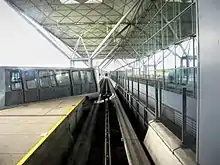 An Adtranz C-100 vehicle approaching the Main Terminal
An Adtranz C-100 vehicle approaching the Main Terminal.jpg.webp) Platform doors at a Transit station
Platform doors at a Transit station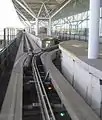 Set of points for a crossover connecting the two tracks
Set of points for a crossover connecting the two tracks A Transit vehicle in the tunnel section
A Transit vehicle in the tunnel section Map of the Stansted Transit System
Map of the Stansted Transit System In-car route information signage
In-car route information signage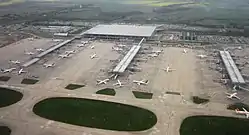 Aerial view of the airport, with the Transit line visible in front of the main terminal
Aerial view of the airport, with the Transit line visible in front of the main terminal C-100 vehicle on elevated guideway section
C-100 vehicle on elevated guideway section
See also
References
- "24. BAA Stansted, Airport Transit System, TTS – The Track Transit System" (PDF). Cambridge University/BAA. Archived from the original (PDF) on 19 July 2011. Retrieved 11 July 2008.
- "In The Terminal". Stansted Airport website. The Manchester Airports Group plc. Archived from the original on 10 January 2018. Retrieved 10 January 2018.
- Simons, Graham; Bowman, Martin W. (2011). London's Airports. Casemate Publishers. pp. 135–6. ISBN 9781848843943. Retrieved 10 January 2018.
- "Section 62A Planning Application: S62A/2023/0022 - London Stansted Airport, Bassingbourn Road, Stansted CM24 1QW". GOV.UK. 31 August 2023. Retrieved 4 September 2023.
- Smiler, Simon. "Monorails, Maglevs and 'Cabin' Transports". citytransport.info. Archived from the original on 10 January 2018. Retrieved 10 January 2018.